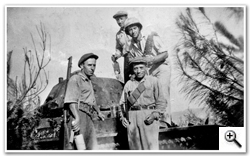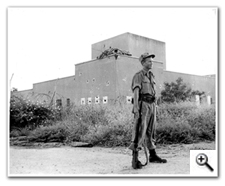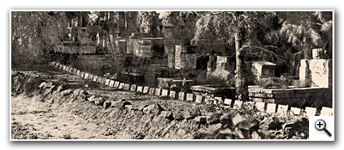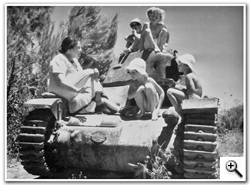
The battle for Degania
A communiqué was sent to the General Staff on May 14th stating that "…aerial reconnaissance has spotted Syrian armored columns north and south of Ein Gev; armored cars passed El-Hama and were seen two kilometers east of Zemach. Degania members manning the trenches and positions on the east side of Degania could see the Syrian army columns advancing, descending to Tel-el-Kasr (the site of Kibbutz Tel Katzir of today) where they established their brigade command post. Facing this Syrian army with its tanks, armored cars, artillery and aircraft stood the Degania people with reinforcements from the "Barak" and "Golani" Brigades and a company from the "Carmeli" Brigade. On May 15th the Syrians began shelling the Jordan Valley settlements with cannon and mortars day and night, on the 17th capturing the "Quarrantine" (where livestock were held) and the "Provincial Corps" Camp, east of Zemach. On the morning of May 18th 1948 a communiqué reached the general staff: "after a heavy bombardment, tanks and armored cars broke through to Zemach at 08:25 hours, capturing it. All of the Jordan Valley settlements, including Yavne'el, were under heavy aerial attack. Enemy tanks are near Degania." The Syrian army waited for the fall of Sha'ar Ha'Golan and Masada (which materialized on May 18-19th) before opening the attack on the Deganias on its way to taking the bridge over the Jordan. On that same night a contingent of senior Jordan Valley residents met with David Ben-Gurion and Yigal Yadin at the General Staff, concluding that a communiqué would be sent to the Golani Brigade: "all efforts are under way so that by tomorrow at four o'clock in the morning four heavy cannon will arrive in Yavne'el
 |
 |
|
After the Syrian Bombing on Degania
1948 |
The Syrian tank at Degania's gates
1948 |
The day of May 19th was uneventful. That night however a platoon of the Palmach's "Yiftach" Brigade attacked the Semack police station and although they succeeded in hitting several armored cars in the compound, they failed to capture it and withdrew back to Degania. On May 20th at 04:30 hours, Syrian forces attacked Degania with tanks, armored vehicles and infantry. The attack commenced with a heavy artillery bombardment during which tanks and armored cars moved out from Zemach to the fields, advancing along the road and in the fields towards Degania. Infantry followed the armor, stopping some 200 meters from the Degania fence and digging in there. The tanks kept moving forward until they reachded the kibbutz fence, where they were halted by the defenders who used a Fiat anti-tank grenade launcher and Molotov cocktails, prepared in advance by the Degania members.
One tank got past the fence and stopped at the edge of a trench while shooting its machine gun in all directions. The defenders threw a Molotov cocktails at it, killing the crew and neutralizing the tank. Mortars positioned at Kibbutz Kinneret and west of Degania behind Beit Gordon made accurate hits on the Syrian infantry encamped in the open fields and also hit armored cars laden with munitions.
|

|

|
|
Degania members how stoped the
Syrian tank |
Semack police station |
Two anti-aircraft guns transferred from the Sha'ar HaGola and Masada area across the Jordan River hit the Syrian armored vehicles and infantry, preventing them from advancing along the road toward the bridge over the Jordan. The four cannon promised by the General Staff arrived and were positioned on the Alumot plateau, although they arrived only after the battle was actually over. The attack on Degania ended at 07:30 with the Syrian army withdrawing to the village of Samah, leaving behind two damaged tanks, two decimated armored cars and dozens of soldiers killed by the defenders' fire.
That afternoon, there began a concerted armor and infantry attack on Degania 'B'; the attack was thwarted and the cannon already positioned on the Alumot plateau, although arriving without proper aiming devices and with little ammunition, had a tremendous effect on the battlefield when they succeeded striking the enemy with direct hits. From captured Syrian documents and transmissions it became evident that the cannon caused fear and confusion among the Syrian command, and were a significant factor in their decision to withdraw.
At about 14:30 hours the Syrians began pulling back towards Zemach and by evening all of the Syrian army had evacuated the Zemach police compound and the surrounding village, encamping at the village of Tel el-Kasr (the site of present day Kubbutz Tel Katzir).
Sixty seven of the fighters killed in the campaign for the defense of the Jordan Valley are buried in the military plot of the Degania cemetery; eight of them (including one woman) were members and sons of Degania.
|

|

|
|
Degania Military Cemetery |
Degania children and their kindergartner
Miriam Zinger Berkowitz on the tank |
After the War of Independence, the Israel Lands Authority allocated some of the Zemach area and other lands to Degania and other Jordan Valley kibbutzim. This brought Degania's cultivated land to a total of 2,000 dunams, including the kibbutz itself. An additional area that Degania gained was that of the hills north of the stream of Tabor and south of the stream of Yavne'el, acquired when the villages of Sirin, Ulamm and Hadatta were abandoned during the war.

From the beginning of 1968 until late 1970, the Jordan Valley settlements, including Degania, found themselves caught in the midst of the War of Attrition raging on the eastern front. The PLO, under the auspices of the Syrian and Jordanian armies, carried out incursions across the border with Israel. Degania and the kibbutzim bore the brunt militarily and economically as well as paying a price in morale due to constant Katyusha rocket fire, artillery bombardment and mines laid along the roads. The continuous Katyusha and mortar fire made the construction of security rooms and bomb shelters necessary. Over this two year period, the children of the Jordan Valley spent long periods of time in bomb shelters, where they were compelled to continue their daily lives under very harsh conditions.
|

